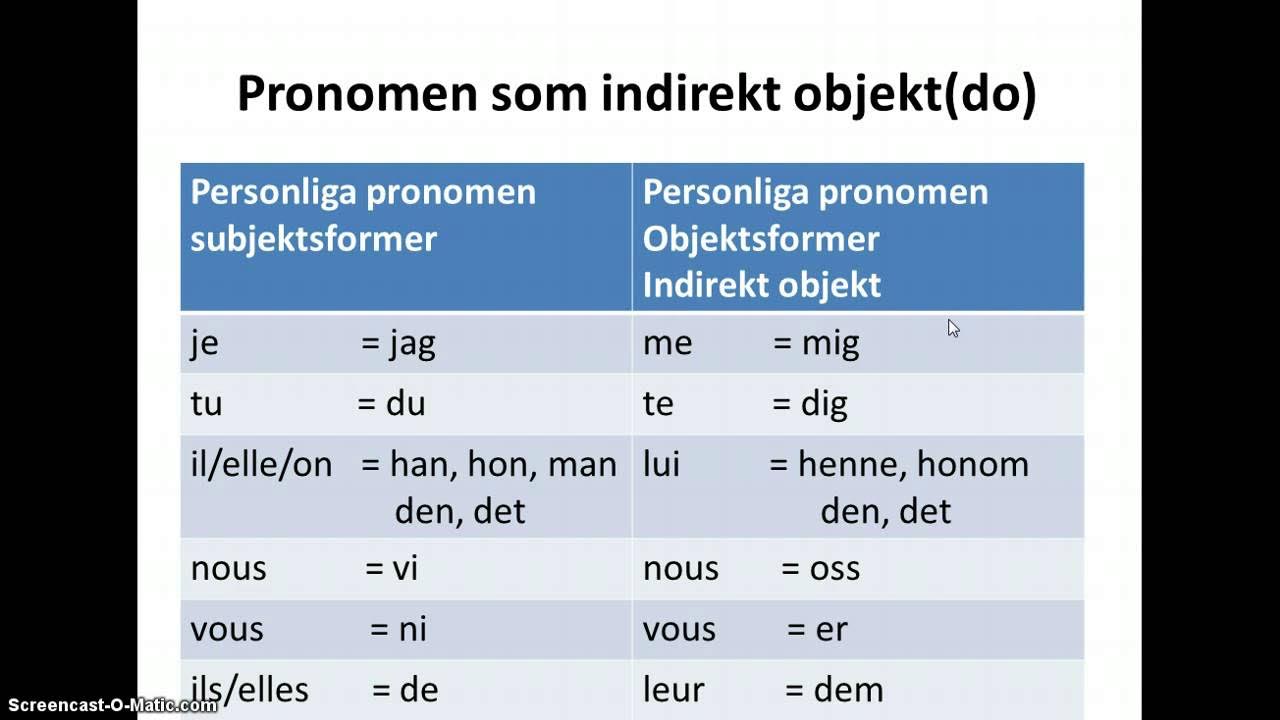French Pronouns
Summary
TLDRThis video explains the different types of French pronouns and how to use them in sentences. It covers subject pronouns, direct and indirect object pronouns, as well as the tricky 'y' and 'en' pronouns. The video clarifies how these pronouns replace previously mentioned words to avoid repetition, making communication smoother. Through various examples, it shows how and where to place these pronouns in French sentences. It also highlights common verb-preposition pairings, and includes a guide to double pronoun order, simplifying complex sentences. Ideal for learners aiming to sound more natural in French.
Takeaways
- 😀 Pronouns are words that replace previously mentioned words to avoid repetition, making communication quicker and more efficient.
- 🔠 In French, a standard sentence structure is subject-verb-object.
- 📋 Subject pronouns are essential in conjugating verbs and include forms like 'je,' 'tu,' 'il/elle,' 'nous,' 'vous,' 'ils/elles.'
- 🏀 Direct object pronouns replace direct objects in sentences and include 'me,' 'te,' 'le/la,' 'nous,' 'vous,' 'les.' They go before the verb.
- 📞 Indirect object pronouns are used when the object is preceded by a preposition (usually 'à'), and include 'me,' 'te,' 'lui,' 'nous,' 'vous,' 'leur.'
- 🌀 Pronouns 'y' and 'en' replace places (for 'y') and quantities (for 'en').
- ⏳ Direct and indirect object pronouns follow the same placement rules: they come before the verb, but after the verb in affirmative imperatives.
- 🧩 In sentences with both a direct and indirect object pronoun, there is a specific order of pronouns that must be followed.
- 🔄 Reflexive pronouns describe actions people perform with or for each other and will be covered in future videos.
- 🎯 The video emphasizes that mastering pronouns, particularly pronoun order, is key to sounding natural and fluent in French.
Q & A
What is a pronoun in French, and why is it important?
-A pronoun in French is a word that replaces a noun to avoid repetition and make communication quicker and more efficient. Understanding pronouns is crucial for sounding more natural and fluid in French conversation.
What are subject pronouns, and can you provide some examples in French?
-Subject pronouns replace the subject of a sentence and are often seen when conjugating verbs. Examples include 'je' (I), 'tu' (you), 'il' (he or it for a masculine noun), 'elle' (she or it for a feminine noun), and 'ils' (they for a masculine group).
What is the difference between direct and indirect object pronouns?
-Direct object pronouns replace nouns that are directly impacted by the verb, with no preposition in between (e.g., 'David voit la pomme' – 'David sees the apple'). Indirect object pronouns replace nouns that are indirectly impacted, usually with a preposition like 'à' in between (e.g., 'David parle à Emma' – 'David is speaking to Emma').
What are the French direct object pronouns?
-French direct object pronouns are: 'me' (me), 'te' (you), 'le' (him or it), 'la' (her or it), 'nous' (us), 'vous' (you plural or formal), and 'les' (them).
Where do direct object pronouns appear in a French sentence?
-Direct object pronouns are placed just before the verb they modify. For example, 'David me voit' (David sees me). In compound tenses, they go before the auxiliary verb, and before the infinitive verb in sentences with both a conjugated verb and an infinitive.
What are some examples of indirect object pronouns in French?
-French indirect object pronouns include 'me' (to me), 'te' (to you), 'lui' (to him/her), 'nous' (to us), 'vous' (to you plural or formal), and 'leur' (to them).
How does pronoun placement differ in imperative sentences?
-In affirmative imperative sentences, object pronouns are placed after the verb. For example, 'mange-le' (eat it). This differs from declarative sentences where pronouns usually come before the verb.
What are the pronouns 'y' and 'en', and how are they used?
-'Y' replaces phrases related to places or 'à' + something, while 'en' replaces 'de' + something. For example, 'J'y vais' (I'm going there) replaces 'Je vais à Paris', and 'J'en veux' (I want some) replaces 'Je veux des pommes'.
Can you use more than one pronoun in the same sentence? If so, how is the order determined?
-Yes, you can use more than one pronoun in a sentence. The order follows a specific structure: subject pronoun → me/te/se/nous/vous → le/la/les → lui/leur → y → en. For example, 'Il me le donne' (He gives it to me).
What is the exception to pronoun order in French?
-The exception to pronoun order occurs in the affirmative imperative, where object pronouns follow the verb in a slightly different order. For example, 'Explique-le-moi' (Explain it to me).
Outlines

Esta sección está disponible solo para usuarios con suscripción. Por favor, mejora tu plan para acceder a esta parte.
Mejorar ahoraMindmap

Esta sección está disponible solo para usuarios con suscripción. Por favor, mejora tu plan para acceder a esta parte.
Mejorar ahoraKeywords

Esta sección está disponible solo para usuarios con suscripción. Por favor, mejora tu plan para acceder a esta parte.
Mejorar ahoraHighlights

Esta sección está disponible solo para usuarios con suscripción. Por favor, mejora tu plan para acceder a esta parte.
Mejorar ahoraTranscripts

Esta sección está disponible solo para usuarios con suscripción. Por favor, mejora tu plan para acceder a esta parte.
Mejorar ahoraVer Más Videos Relacionados

Genomgång av indirekt objekt i franska

Understanding the 8 Parts of Speech | Grammar Essentials | EasyTeaching

French Subject Pronouns - easy guide! ( full transcript underneath)

Penggunaan Pronouns dalam Bahasa Inggris

Ism Maushul (Kata Sambung) - BAHASA ARAB KELAS 9 MTS/SMP (BAB 5 : SESI 2)

Nouns and Pronouns
5.0 / 5 (0 votes)
